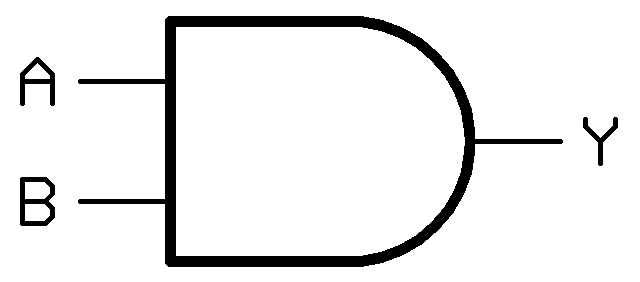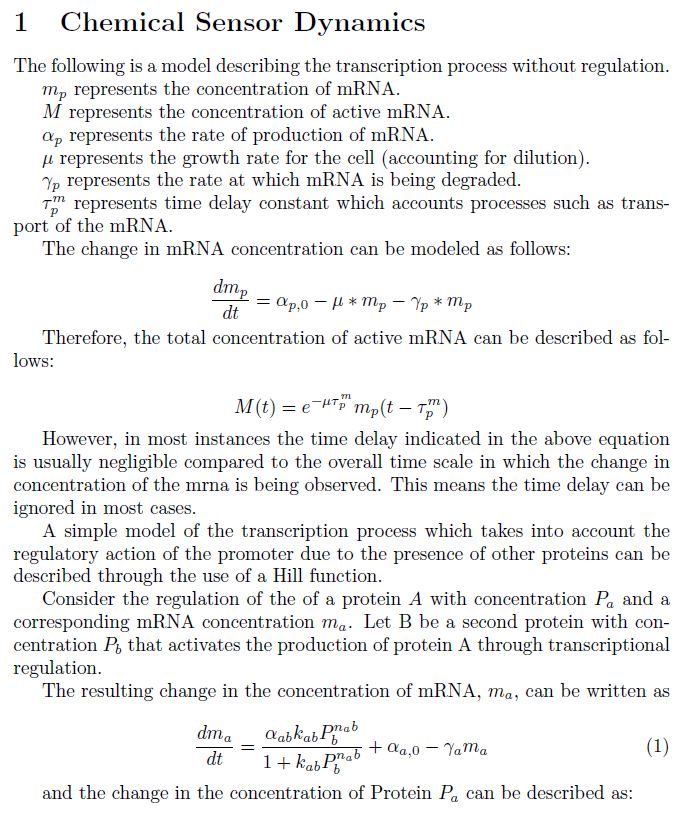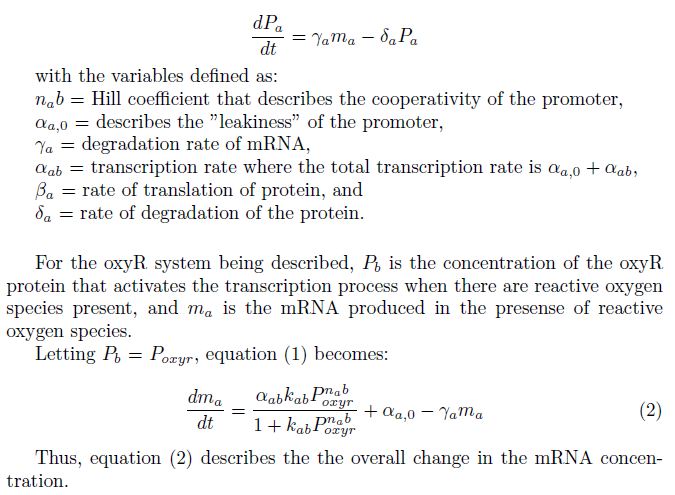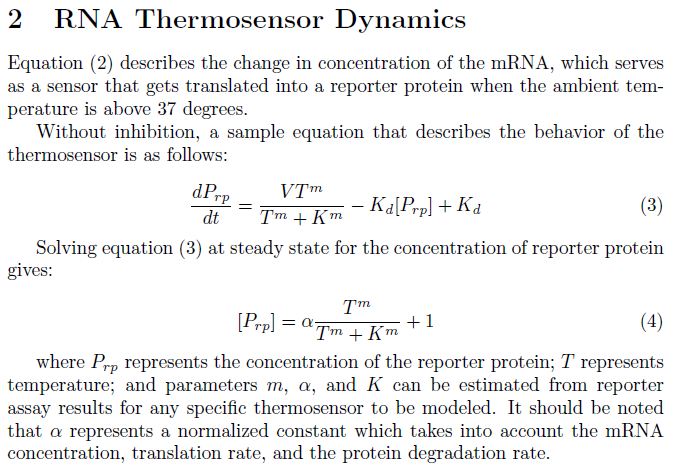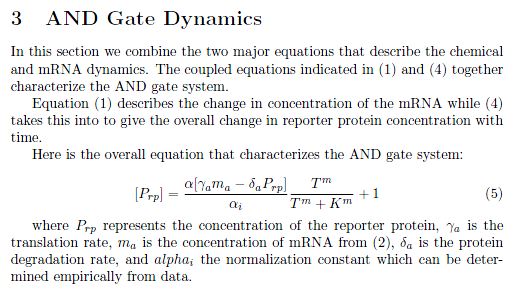Team:BYU Provo/Modeling
From 2011.igem.org
(→Modeling the AND Gate: Putting It All Together) |
|||
| (22 intermediate revisions not shown) | |||
| Line 9: | Line 9: | ||
[[File:AND Gate.png|200px|thumb|right|AND Gate]] | [[File:AND Gate.png|200px|thumb|right|AND Gate]] | ||
| - | In other fields such as electrical or software engineering, logic gates form the foundation of decision-making circuits. Our project was to build a simple logic gate in <i>E. coli</i> from modular molecular parts. This year we built an AND gate. An AND gate works by only producing an output in the presence of two inputs. In the figure to the right, "A" and "B" are the inputs, and "Y" is the output. In this case, If either A, B, or both inputs are missing, then "Y" will not be expressed. | + | In other fields such as electrical or software engineering, logic gates form the foundation of decision-making circuits. Our project was to build a simple logic gate in <i>E. coli</i> from modular molecular parts. This year we built an [http://en.wikipedia.org/wiki/AND_gate AND gate]. An AND gate works by only producing an output in the presence of two inputs. In the figure to the right, "A" and "B" are the inputs, and "Y" is the output. In this case, If either "A", "B", or both inputs are missing, then "Y" will not be expressed. |
| - | Our molecular AND gate works by the same principle as conventional AND gates. Input "A" in our construct can be | + | Our molecular AND gate works by the same principle as conventional AND gates. Input "A" in our construct can be any regulated promoter. In testing our construct we used two promoters: Pbad (a common, arabinose-inducible promoter) and PsoxS (a naturally occurring, reactive oxygen species-inducible promoter). These can be classed generally as "chemical sensors". Input "B" in our construct is a temperature dependent RNA switch or "thermosensor". Ouput "Y" can be any reporter gene. We have alternately used lacZ (turns blue in presence of X-gal), Superfolder GFP (fluoresces green), and an iGEM enzyme that produces [http://partsregistry.org/wiki/index.php?title=Part:BBa_J45270 banana smell]. |
| - | Modeling the AND gate is similar for any combination of parts. To simplify this discussion, assume the Pbad promoter (an "arabinose" sensor"), the wild-type <i>Lysteria</i> thermosensor (a "heat" sensor), and GFP (our reporter or "output"). | + | Modeling the AND gate is similar for any combination of parts. To simplify this discussion, assume the Pbad promoter (an "arabinose" sensor"), the wild-type <i>Lysteria</i> thermosensor (a "heat" sensor), and GFP (our reporter or "output"). |
| + | |||
| + | [[File:X ray E.png|right|X-Ray]] | ||
| + | The most obvious use of a molecular AND gate is to create dual-input biosensors. A possible application is in detecting colon cancer. Colon cancer polyps produce high amounts of reactive oxygen species (ROS) and are higher in temperature than the surrounding colon tissue. A sensor for either of these inputs alone would be confounded by normal physiological variation in temperature and ROS. A dual-input sensor can effectively "ignore" this variation, and would only express a reporter molecule in the presence of both heat and ROS, significantly increasing the chances of finding actual polyps. | ||
==Molecular AND Gate Function== | ==Molecular AND Gate Function== | ||
| - | [[File:Simple_Modeling_Diagram.jpg| | + | [[File:Simple_Modeling_Diagram.jpg|300px|thumb|center|Simple Molecular AND Gate]] |
| + | The figure above displays a simplified molecular AND gate. Input "A" in this case is arabinose, which induces downstream <b>transcription</b> from the Pbad promoter. The thermosensor and reporter gene are transcribed, and complimentary sequences in the resulting RNA bind together to fold into the thermosensor. The ribosomal binding site and start codon are embedded in the thermosensor structure. As long as the thermosensor is folded, it prevents <b>translation</b> of the reporter gene. Input "B" is heat. When the ambient temperature crosses a threshold (in this case, 37 degrees C), the complimentary sequences within the thermosensor melt apart and allow translation of the reporter gene. Output "Y" is GFP. If GFP is present, we can conclude that the AND gate was exposed to both inputs - arabinose and heat. | ||
| + | |||
| + | In modeling this system, it is important to note that input "A" controls transcription, and input "B" controls translation. | ||
| + | |||
| + | |||
| + | [[File:Complicated_Modeling_Diagram.jpg|300px|thumb|center|Final AND Gate]] | ||
| + | Our full AND gate contains one extra function more than the simple model described above. We use a [http://en.wikipedia.org/wiki/Cre-Lox_recombination Cre/Lox] system in order to achieve a sustained (constitutive) level of output "Y" after possibly transitory levels of inputs "A" and "B". To accomplish constitutive reporter expression, we put our reporter under the control of a constitutive synthetic promoter. As can be seen in the above figure, inputs "A" and "B" allow transcription and translation of the Cre protein. Cre is a site-specific recombinase that loops out any DNA between two identical 34 base sites called Lox sites. In our final construct, we cloned two Lox sites that sandwiched two transcriptional terminators in between the constitutive promoter and the reporter. While the Lox sites containing the double-terminators are present, the reporter is silent. When the AND gate allows transcription of cre, Cre removes the Lox sites and the double-terminator, allowing the reporter to be constitutivley expressed from that point on. | ||
| + | |||
| + | ==Modeling Input A: The Promoter== | ||
| + | |||
| + | [[File:Modeling1.JPG|550px|center]] | ||
| + | |||
| + | [[File:BYUModeling2.JPG|550px|center]] | ||
| + | |||
| + | ==Modeling Input B: The Thermosensor== | ||
| + | [[File:BYUModeling3.JPG|550px|center]] | ||
| + | |||
| + | ==Modeling the AND Gate: Putting It All Together== | ||
| + | [[File:BYUModeling4.JPG|550px|center]] | ||
| + | ==Acknowledgements== | ||
| + | Modeling was performed by [https://2011.igem.org/Team:BYU_Provo/Team/Julius Julius Adebayo]. One very useful resource was the book [http://www.cds.caltech.edu/~murray/amwiki/index.php/Main_Page "Feedback Systems: An Introduction for Scientists and Engineers"] by [http://www.cds.caltech.edu/~murray/amwiki/index.php/Karl_J._%C3%85str%C3%B6m Karl J. Åström] and [http://www.cds.caltech.edu/~murray/amwiki/index.php/Richard_M._Murray Richard M. Murray]. | ||
</div> | </div> | ||
Latest revision as of 03:52, 29 September 2011

|
Contents |
Overview
In other fields such as electrical or software engineering, logic gates form the foundation of decision-making circuits. Our project was to build a simple logic gate in E. coli from modular molecular parts. This year we built an [http://en.wikipedia.org/wiki/AND_gate AND gate]. An AND gate works by only producing an output in the presence of two inputs. In the figure to the right, "A" and "B" are the inputs, and "Y" is the output. In this case, If either "A", "B", or both inputs are missing, then "Y" will not be expressed.
Our molecular AND gate works by the same principle as conventional AND gates. Input "A" in our construct can be any regulated promoter. In testing our construct we used two promoters: Pbad (a common, arabinose-inducible promoter) and PsoxS (a naturally occurring, reactive oxygen species-inducible promoter). These can be classed generally as "chemical sensors". Input "B" in our construct is a temperature dependent RNA switch or "thermosensor". Ouput "Y" can be any reporter gene. We have alternately used lacZ (turns blue in presence of X-gal), Superfolder GFP (fluoresces green), and an iGEM enzyme that produces [http://partsregistry.org/wiki/index.php?title=Part:BBa_J45270 banana smell].
Modeling the AND gate is similar for any combination of parts. To simplify this discussion, assume the Pbad promoter (an "arabinose" sensor"), the wild-type Lysteria thermosensor (a "heat" sensor), and GFP (our reporter or "output").
The most obvious use of a molecular AND gate is to create dual-input biosensors. A possible application is in detecting colon cancer. Colon cancer polyps produce high amounts of reactive oxygen species (ROS) and are higher in temperature than the surrounding colon tissue. A sensor for either of these inputs alone would be confounded by normal physiological variation in temperature and ROS. A dual-input sensor can effectively "ignore" this variation, and would only express a reporter molecule in the presence of both heat and ROS, significantly increasing the chances of finding actual polyps.
Molecular AND Gate Function
The figure above displays a simplified molecular AND gate. Input "A" in this case is arabinose, which induces downstream transcription from the Pbad promoter. The thermosensor and reporter gene are transcribed, and complimentary sequences in the resulting RNA bind together to fold into the thermosensor. The ribosomal binding site and start codon are embedded in the thermosensor structure. As long as the thermosensor is folded, it prevents translation of the reporter gene. Input "B" is heat. When the ambient temperature crosses a threshold (in this case, 37 degrees C), the complimentary sequences within the thermosensor melt apart and allow translation of the reporter gene. Output "Y" is GFP. If GFP is present, we can conclude that the AND gate was exposed to both inputs - arabinose and heat.
In modeling this system, it is important to note that input "A" controls transcription, and input "B" controls translation.
Our full AND gate contains one extra function more than the simple model described above. We use a [http://en.wikipedia.org/wiki/Cre-Lox_recombination Cre/Lox] system in order to achieve a sustained (constitutive) level of output "Y" after possibly transitory levels of inputs "A" and "B". To accomplish constitutive reporter expression, we put our reporter under the control of a constitutive synthetic promoter. As can be seen in the above figure, inputs "A" and "B" allow transcription and translation of the Cre protein. Cre is a site-specific recombinase that loops out any DNA between two identical 34 base sites called Lox sites. In our final construct, we cloned two Lox sites that sandwiched two transcriptional terminators in between the constitutive promoter and the reporter. While the Lox sites containing the double-terminators are present, the reporter is silent. When the AND gate allows transcription of cre, Cre removes the Lox sites and the double-terminator, allowing the reporter to be constitutivley expressed from that point on.
Modeling Input A: The Promoter
Modeling Input B: The Thermosensor
Modeling the AND Gate: Putting It All Together
Acknowledgements
Modeling was performed by Julius Adebayo. One very useful resource was the book [http://www.cds.caltech.edu/~murray/amwiki/index.php/Main_Page "Feedback Systems: An Introduction for Scientists and Engineers"] by [http://www.cds.caltech.edu/~murray/amwiki/index.php/Karl_J._%C3%85str%C3%B6m Karl J. Åström] and [http://www.cds.caltech.edu/~murray/amwiki/index.php/Richard_M._Murray Richard M. Murray].
 "
"
